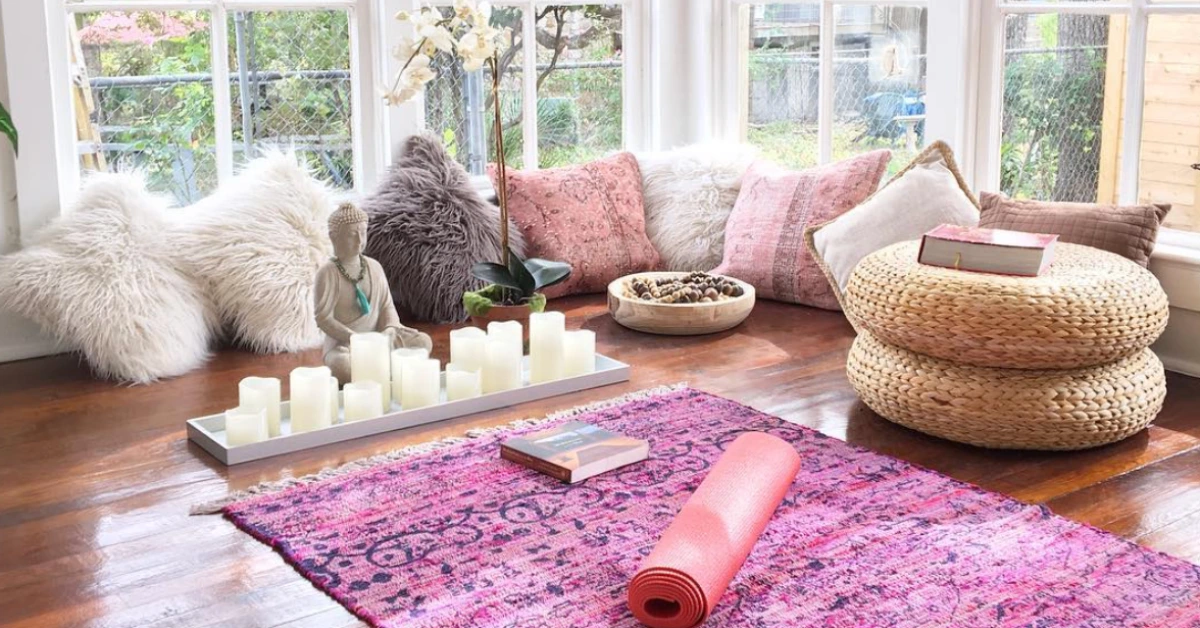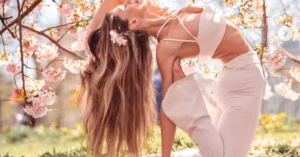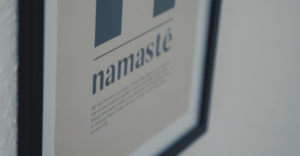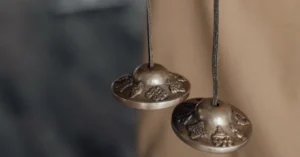Step into a realm where the hues of tranquility dance with the essence of inner peace—welcome to the enchanting world of “Meditation Room Colors.” In the symphony of serenity, the colors surrounding us play a significant role in creating an atmosphere conducive to mindfulness and relaxation.
This article serves as your palette, guiding you through the art and science of selecting the perfect 5 meditation room colors. From soothing pastels to vibrant earth tones, we’ll explore how each shade can influence your mental state, enhance focus, and foster a sense of calm within your dedicated meditation space.
I love this Yoga mat 🧘🏼♀️
✅ Anti-Slip Surface ✅ Effortless Cleaning
✅ Conscious & Safe Materials
The Psychedelic Spectrum of Meditation Room Colors
As someone who has spent countless hours meditating in various rooms, I can attest to the fact that the color of the walls can have a significant impact on the experience. Some colors are calming and help to create a peaceful atmosphere, while others can be distracting or even irritating.
But have you ever considered the psychedelic potential of meditation room colors? That’s right, I’m talking about colors that can take you on a trip without the need for any mind-altering substances.
Let’s start with blue. This calming color is often associated with the ocean or the sky, and it can help to create a sense of openness and expansiveness. But if you stare at a bright blue wall for long enough, you might start to see some interesting patterns and shapes. It’s like staring into a crystal ball, but without the need for a fortune teller.
Next up is green. This color is often associated with nature and can help to create a sense of balance and harmony. But if you really focus on a bright green wall, you might start to see some trippy visuals. It’s like taking a stroll through a magical forest, but without the need for any mushrooms.
Yellow is another color that can be both calming and trippy. This sunny color can help to create a sense of warmth and happiness, but if you stare at a bright yellow wall for long enough, you might start to see some crazy patterns and shapes. It’s like taking a trip to the sun, but without the need for a spaceship.
Of course, not all colors are created equal when it comes to psychedelic potential. Red, for example, is a powerful color that can evoke strong emotions, but it’s not particularly trippy. And while black might be a popular color for meditation room colors, it’s not exactly known for its psychedelic properties.
So if you’re looking to take your meditation practice to the next level, consider experimenting with some psychedelic colors. Just be sure to have a comfortable place to sit and some water nearby, in case things get a little too trippy. A color meditation is the perfect meditation for a meditation room.
The Zen of White and Black as Meditation Room Colors

As someone who has been practicing meditation for years, I can attest to the importance of creating a peaceful and calming environment for your practice. One of the key elements of this environment is the color scheme of the room. In this section, I will explore the Zen of white and black, two colors that are often used as meditation room colors.
White: The Color of Cosmic Consciousness
White is a popular color choice for meditation room colors because it represents purity, clarity, and cosmic consciousness. It is the color of the void, the space between thoughts, and the ultimate reality beyond form and color. When you meditate in a white room, you are surrounded by a sense of spaciousness and openness, which can help you let go of your thoughts and connect with your inner self.
But white is not just a color of emptiness. It is also a color of fullness, representing the full spectrum of light. When you meditate in a white room, you are bathing in the full spectrum of cosmic energy, which can help you feel energized and revitalized.
Black: The Shade of Deep Contemplation
Black is another popular color choice for meditation room colors, and for good reason. It represents the unknown, the mystery, and the deep, dark void of the universe. When you meditate in a black room, you are surrounded by a sense of depth and stillness, which can help you go deeper into your practice and access the hidden depths of your consciousness.
But black is not just a color of darkness. It is also a color of power, representing the strength and resilience of the universe. When you meditate in a black room, you are tapping into the power of the universe, which can help you feel more grounded and centered.
The colors you choose for your meditation room can have a profound impact on your practice. Whether you choose white for its purity and clarity, or black for its mystery and depth, make sure you create a space that feels peaceful and calming to you.
Feeling Blue or Seeing Red? – Additional Meditation Room Colors

As I was designing my meditation room, I found myself pondering the age-old question: what color should I paint the walls? After some research and reflection, I discovered that different colors can evoke different emotions and have varying effects on the mind and body during meditation. Here are my findings on the two most popular colors for meditation room colors: blue and red.
Blue: The Hue of Tranquility
Blue is a calming color that is often associated with tranquility, peace, and relaxation. It can lower blood pressure, slow down the heart rate, and reduce feelings of anxiety and stress. Blue is also said to enhance creativity and promote a sense of serenity, making it an ideal color for meditation rooms.
If you’re considering blue for your meditation room, keep in mind that different shades can have different effects. Lighter shades of blue, such as baby blue or sky blue, can create a soothing and calming atmosphere. Darker shades, such as navy or royal blue, can evoke a sense of stability and security.
Red: The Tint of Passionate Focus
Red is a warm and energizing color that is often associated with passion, excitement, and motivation. It can increase heart rate, stimulate the senses, and enhance concentration and focus. Red is also said to promote feelings of courage and confidence, making it a great color for those who want to feel more empowered during their meditation practice.
However, be careful when using red in your meditation room, as it can also evoke feelings of anger and aggression if used in excess. If you decide to incorporate red into your meditation room, consider using it as an accent color rather than the main color.
Going Green: The Color of Nature’s Embrace – Additional Meditation Room Colors

Ah, the color green. It’s the color of nature, the color of life, and the color of envy (but let’s not focus on that last one). When it comes to creating a meditation room, green is the perfect color to embrace.
Why, you ask? Well, for starters, green is a calming color. It’s been shown to reduce anxiety and promote relaxation, which is exactly what you want in a meditation space. Plus, it’s the color of plants, which are known for their air-purifying properties. So not only will your meditation room look great, but it’ll also be healthier for you.
But not all greens are created equal. When choosing a shade of green for your meditation room colors, consider the following:
- Light greens: These shades are perfect for creating a serene, calming atmosphere. Think mint green or sage green. They’re also great for smaller spaces, as they can make a room feel more open and airy.
- Dark greens: These shades are a bit more dramatic and moody. Think forest green or emerald green. They’re perfect for larger spaces or for creating a more intimate, cozy atmosphere.
- Olive greens: These shades are a bit more muted and earthy. They’re perfect for creating a natural, organic feel in your meditation space. Plus, they pair well with other earthy colors like browns and beiges.
So there you have it, folks. When it comes to creating meditation room colors, going green is the way to go. Just remember to choose the right shade of green for your space, and you’ll be well on your way to a more relaxing, peaceful meditation experience.
Yellow: The Sunshine of Your Meditation Room Colors

Ah, yellow. The color of sunshine, happiness, and optimism. It’s no wonder that this color is perfect for a meditation room. When I walk into a room with yellow walls, I can’t help but feel a sense of calm and joy wash over me. Here are a few reasons why yellow is the perfect color for your meditation space:
Yellow is uplifting
Yellow is known for its ability to uplift your mood. It’s a color that can bring joy and optimism into your life. When you’re feeling down or anxious, spending time in a yellow room can help boost your spirits and make you feel more positive.
Yellow is energizing
Yellow is also an energizing color. It can help wake you up and give you the energy you need to start your day. If you meditate in the morning, a yellow room can help you get into the right mindset and prepare you for the day ahead.
Yellow is calming
Despite its energizing qualities, yellow is also a calming color. It can help reduce anxiety and stress and promote relaxation. When you’re meditating, you want to be in a calm and peaceful state of mind, and yellow can help you achieve that.
Yellow is associated with the sun
Finally, yellow is associated with the sun, which is a powerful symbol of life and energy. When you’re meditating, you’re tapping into the energy of the universe, and the sun is a powerful source of that energy. A yellow room can help you connect with that energy and feel more in tune with the universe.
If you want to create a meditation room that promotes joy, optimism, and relaxation, consider painting the walls yellow. It’s a color that can help uplift your mood, energize your body, and calm your mind. So go ahead, bask in the sunshine of your yellow meditation room colors and let the positive energy flow.
Purple: The Royal Road to Relaxation In Your Meditation Room Colors

Ah, purple! The color of royalty, luxury, and relaxation. If you want to add a touch of regal elegance to your meditation room, then purple is the perfect color for you.
But purple isn’t just about looking fancy. It’s also a color that’s associated with relaxation and calmness. In fact, studies have shown that purple can help to reduce anxiety and stress, making it an ideal color for a meditation space.
So why is purple so relaxing? Well, for one thing, it’s a color that’s often associated with spirituality and mysticism. In many cultures, purple is seen as a color that represents the divine, making it a natural choice for a meditation room.
But there’s more to it than just cultural associations. Purple is also a color that has a calming effect on the mind and body. It’s a soothing color that can help to slow down your thoughts and ease your worries.
If you’re not sure how to incorporate purple into your meditation room, there are plenty of options to choose from. You could paint the walls a soft shade of lavender, add some purple cushions to your meditation cushion collection, or even hang some purple tapestries on the walls.
Whatever you choose, just remember that purple is a color that’s all about relaxation and tranquility. So sit back, close your eyes, and let the soothing power of purple wash over you.
FAQ
How do meditation room colors affect meditation practices, and why are they significant in a meditation space?
Meditation room colors play a crucial role in setting the tone and atmosphere of a meditation space. Different colors can evoke specific emotions and moods, influencing the practitioner’s state of mind during meditation. Creating a harmonious color scheme contributes to a serene and calming environment conducive to a focused meditation practice.
Are there specific colors that are recommended for a meditation room colors, and how do they impact the meditation experience?
Soft, muted tones like blues, greens, and earthy neutrals are often recommended for meditation rooms. These colors are associated with calmness, serenity, and a connection to nature. Blues can instill a sense of peace, greens symbolize growth and balance, while earthy tones offer grounding and stability, fostering an ideal ambiance for meditation.
Can bold or brighter colors be used in a meditation room colors, and how might they influence meditation sessions?
While softer tones are commonly suggested, some individuals find that brighter colors, such as vibrant oranges, deep purples, or rich reds, can enhance their meditation experiences. Bold colors can evoke energy, creativity, and passion. However, their impact on meditation may vary among individuals, as some may find these shades too stimulating for a calm practice.
How can one choose the right color for their meditation room colors, and are there personal preferences to consider?
When choosing a color for a meditation room colors, consider personal preferences and the intended atmosphere. Reflect on the feelings and associations you have with various colors. It’s essential to select a color that resonates with a sense of calm, relaxation, and focus for your individual meditation practice. Experimenting with different shades and observing their impact can help in deciding the most suitable color scheme for your meditation space.
If you liked this blog article about meditation room colors, don’t forget to follow us on Pinterest so you don’t miss any more meditation news!








Actually really nice, great group of individuals.